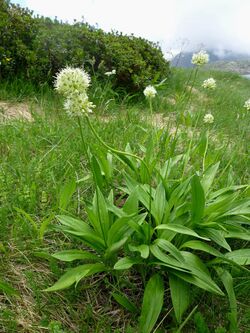Biology:Allium victorialis
| Allium victorialis | |
|---|---|

| |
| Scientific classification | |
| Script error: No such module "Taxobox ranks".: | Plantae |
| Script error: No such module "Taxobox ranks".: | Tracheophytes |
| Script error: No such module "Taxobox ranks".: | Angiosperms |
| Script error: No such module "Taxobox ranks".: | Monocots |
| Script error: No such module "Taxobox ranks".: | Asparagales |
| Script error: No such module "Taxobox ranks".: | Amaryllidaceae |
| Script error: No such module "Taxobox ranks".: | Allioideae |
| Script error: No such module "Taxobox ranks".: | Allium |
| Script error: No such module "Taxobox ranks".: | A. subg. Anguinum |
| Script error: No such module "Taxobox ranks".: | <div style="display:inline" class="script error: no such module "taxobox ranks".">A. victorialis |
| Binomial name | |
| Allium victorialis | |
| Synonyms[2] | |
|
Synonymy
| |
Allium victorialis, commonly known as victory onion, Alpine leek, and Alpine broad-leaf allium[3] is a broad-leaved Eurasian species of wild onion. It is a perennial of the Amaryllis family that occurs widely in mountainous regions of Europe and parts of Asia (Caucasus and Himalayas).[2][4]
Some authors consider certain East Asian and Alaskan populations as constituting subspecies platyphyllum within the species Allium victorialis.[5][6] Recent sources recognize this group as a distinct species, called Allium ochotense.[7][8][9][10][11]
General description
Allium victorialis attains a height of 30–45 cm (11.8–17.7 in) and forms a sheathed bulb ("root-stalk") about the thickness of a finger and 5–8 cm (2.0–3.1 in) long.[12] Leaves are broad, elliptical or lanceolate. Flowers (perianths) are whitish green.[12]
Distribution
Allium victorialis is found widely across mountain ranges Europe, as well as the Caucasus and the Himalayas.[2]
Nomenclature
The specific epithet victorialis comes from the German Siegwurz (Root of Victory),[13] and it earned this name having been "worn as an amulet, to be as safeguard against the attacks of certain impure spirits," by Bohemian miners among others.[13]
Uses
The plant, in past centuries in certain mountainous regions of Europe, "was cultivated as a medicinal and fetish plant".[14] It was also recorded as consumed by Ainu people in northern Japan.[15]
See also
- sansai
- ramsons
- Allium tricoccum (ramps)
References
- ↑ Holubec, V., Magos Brehm, J., Uzundzhalieva, K., Vögel, R., Vörösváry, G., Eliáš, P. & Duarte, M.C. (2011). Allium victorialis. The IUCN Red List of Threatened Species 2011: e.T172231A6854104. Downloaded on 05 January 2019.
- ↑ 2.0 2.1 2.2 Kew World Checklist of Selected Plant Families, Allium victorialis
- ↑ Korea National Arboretum (2015). English Names for Korean Native Plants. Pocheon: National Arboretum. pp. 348. ISBN 978-89-97450-98-5. http://www.forest.go.kr/kna/special/download/English_Names_for_Korean_Native_Plants.pdf. Retrieved 27 November 2016.
- ↑ Altervista Flora Italiana, Aglio serpentino, victory onion, alpine leek, Allium victorialis L. includes photos and European distribution map
- ↑ Flora of North America Vol. 26 Page 234 Allium victorialis Linnaeus, Sp. Pl. 1: 295. 1753.
- ↑ Flora of China Vol. 24 Page 172 茖葱 ge cong Allium victorialis Linnaeus, Sp. Pl. 1: 295. 1753.
- ↑ Kew World Checklist of Selected Plant Families, Allium ochotense Prokh.
- ↑ The Plant List, Allium ochotense Prokh.
- ↑ Kharkevich, S.S. (ed.) (1987). Plantae Vasculares Orientalis Extremi Sovietici 2: 1-448. Nauka, Leningrad.
- ↑ Denisov, N. (2008). Addition to Vascular flora of the Kozlov island (Peter the Great Gulf, Japanese sea). Turczaninowia 11(4): 29-42.
- ↑ Choi & Oh 2011.
- ↑ 12.0 12.1 Thompson, Harold Stuart (1912) (preview). Sub-alpine Plants: Or, Flowers of the Swiss Woods and Meadows. G. Routledge & Sons. p. 280. https://books.google.com/books?id=BhwyAQAAMAAJ&pg=PA280.. 1–1.5 ft (0.30–0.46 m) height; and rootstalk 5.1–7.6 cm (2–3 in).
- ↑ 13.0 13.1 Sims, John (1809). "Allium victorialis. Long-rooted garlic". Curtis's Botanical Magazine 30: 1222–. https://books.google.com/books?id=OkwCAAAAYAAJ&pg=RA4-PA1222.
- ↑ Rabinowitch, Haim D.; Currah, Lesley (2002) (preview). Allium Crop Science: Recent Advances. CABI. p. 26. ISBN 978-0851-99510-6. https://books.google.com/books?id=dE7a8SJ9Q7AC&pg=PA26.
- ↑ Bachelor, John (1893). "Ainu Economic Plants". https://www.tota.world/article/179/.
Bibliography
- Choi, Hyeok JAE; Oh, Byoung UN (October 2011). "A partial revision of Allium (Amaryllidaceae) in Korea and north-eastern China". Botanical Journal of the Linnean Society 167 (2): 153–211. doi:10.1111/j.1095-8339.2011.01166.x. https://www.researchgate.net/publication/259483667.
External links
Wikidata ☰ Q162924 entry
 |


